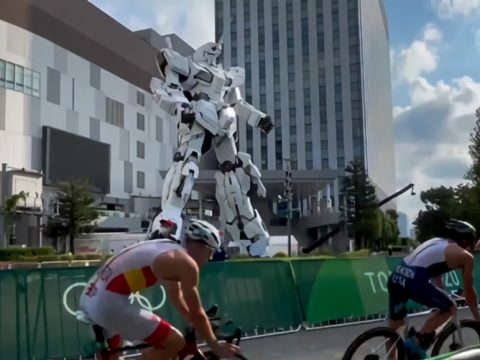Let’s face it, the world presented in Gad Guard is kind of a bummer of a future. Our resources have run from low to nearly non-existent, and as a result the world has been divided into Units. One such unit has itself been divided into class-based sections known as Gold Town, Day Town, and Night Town. It’s within the lights-off-after-midnight ghetto of the latter that we find our hero, Hajiki Sanada; just the kind of street-roaming “teenager with attitude” one might expect to run into in these grim times.
Hajiki isn’t really a bad kid, though. He just wants to survive in Night Town, but things change when he finds a mysterious item known as a Gad. This small object reacts to Hajiki, suddenly turning into a 20-foot tall robot he comes to call Lightning. He isn’t the only one to bring out one of these chrome companions, though. Soon, he’s part of a battle against others like himself, beyond which the true mystery of the Gads remains.
Gad Guard has a lot going for it from the start, though it takes advantage of only a fraction of its potential. First up is the primary setting, Night Town. Slums covered in graffiti, full of desperate impoverished citizens that might snatch anything that’s not nailed down. Yet something’s vacant and lifeless about it at times, and it doesn’t come off as a purposeful feature of the city.
Waging the show’s battles on these streets really brings this issue to the forefront. The plight of the main cast seems strangely insular, like they’re all fighting some imaginary high-stakes battle that doesn’t affect anyone else. After they pound around for a while, trying to defeat each other while standing on the shoulders of their Techodes, the police sirens start wailing, signaling the perfect time for a speedy exit.
One of the policewomen in the show addresses and dismisses this ghost town phenomenon with a single line of dialogue: “When things happen here, everyone turns a blind eye.” Fair enough.
This probably comes off as immediate nitpicking, but in a setting that could have been so full of life, it was disappointing to see it as anything but. I actually started to hold this bizarre hope that the show would conclude by revealing that every single character is criminally insane. Running around at night, concocting hallucinatory visions of mighty robots, and ultimately left cackling in a straight jacket at the local Unit asylum. Apologies if some consider this a strange new form of spoiler, but I think I can guiltlessly reveal that this is not what happens.
Nope, no one here is actually crazy, just difficult to form a connection with. Gad Guard‘s chief antagonist, Katana, ends up being the character with the most intriguing story, even if he exudes pure generic, flat villain when he first appears. Katana’s desperate attempts to take the city as his own are more driven affairs than most anything Hajiki is involved in, but there are only one or two opportunities taken to explore his backstory. Though I don’t think it could carry the whole show, I kept wondering what Gad Guard would be like had it followed Katana more closely.
Let’s not beat around the bush. Beyond the story and the characters, what Gad Guard truly lacks is style. Gonzo’s work on this series is an offering with little heart behind it. I’m not saying anyone in particular is to blame. I don’t know, it may have been 100% budgetary, but, to quote Ichi the Killer‘s Kakihara in the most unlikely of places, “there’s no love in your punches.”
Techodes (and their dark counterparts, A-Techodes) ravage one another with a lifelessness that, while appropriate to the essence of machines, seems contradictory to Toshiharu Murata’s (You’re Under Arrest, Getbackers) exuberant mechanical design. Hajiki and Katana’s Techodes, Lightning and Zero, almost look like characters Sega would create for a mech-brawlin’ Sonic the Hedgehog spin-off, so it’s a shame to see them stiffly jolting about with little to no panache.
In the end, the peaks and valleys of Gad Guard are too unevenly dispersed. One of the major moments that really clicked with me didn’t even occur until the mid-point of episode 23, and it would have been much more successful as a series centerpiece. That’s what makes it difficult to rip into the show so brazenly. The conclusion is pretty satisfying, and the last few episodes might be the best the series has to offer, with a genuine sweetness to them at that. Unfortunately, I can’t in good conscience recommend that anyone sit through a so-so meal just for some decent dessert.
Studio/Company: FUNimation
Available: Now
Rating: TV
© Yoshitsune Izuna • GONZO • Hiroshi Nishikiori / TEAM GADGUARD


![SSSS.Dynazenon [Anime Review] SSSS.Dynazenon [Anime Review]](https://otakuusamagazine.com/wp-content/uploads/2021/08/16-9-SSSS.Dynazenon_Key_Visual_3.5-480x360.jpg)
![Back Arrow [Anime Review] Back Arrow [Anime Review]](https://otakuusamagazine.com/wp-content/uploads/2021/07/ba15-02686-480x360.jpg)



